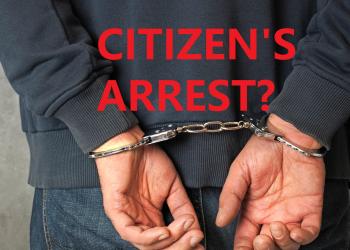From the Classroom
By Raymond Hill
Professor Emeritus, Santa Rosa Junior College
Citizen’s Arrests: Accepting a private person’s arrest for a misdemeanor committed outside an officer’s presence
Background and Case Citations
Previously published case and article references on www.legalupdates.com:
-
Serving Misdemeanor Arrest Warrants After 10 p.m. Inside a Residence – Three Perspectives (8/13/23) LU Ref. #CAB00218 (Ray Hill)
-
Disturbing the Peace and Refusal to Identify (11/27/22) LU Ref. #CAC00088 (Bob Phillips) – Vanegas v. City of Pasadena (9th Cir. Aug. 31, 2022) 46 F.4th 1159
-
Stale or Cold Misdemeanor Rule – An Update (4/28/22) LU Ref. #CAB00146 (Ray Hill)
Question
A citizen observes a misdemeanor vandalism and calls in the crime. The responding officer detains the suspect, there is a positive ID and the officer explains private person arrest (citizen’s arrest) procedures. However, the citizen is hesitant to make an arrest. Can the officer initiate an arrest?
The statute rule is that an officer cannot make an arrest for a misdemeanor that is committed outside his or her presence [836(a) (1) P.C.; P.O.S.T. Basic Police Academy Training Standard – Learning Domain #15 Workbook Version 4.16 (4/22) – Conditions for Making a Warrantless Misdemeanor Arrest.] There are exceptions for minors (625W&I), DUI after a traffic accident (40300.5 V.C.), domestic violence assault or battery (836(d) P.C.), assault or battery on school grounds (243.5 P.C.) and others.
However, appellate courts interpreting the Fourth Amendment have made it abundantly clear that there is only one legal requirement for a peace officer to make an arrest: the existence of probable cause. Probable cause is defined as a “fair probability” or “substantial chance” of criminal activity by the arrestee based on the “totality of the circumstances” known to an officer at the time of arrest” (Vanegas v. City of Pasadena (2022) 9th Circ. 46 F. 4th 1159.)
“Incorporating state arrest rules into the Constitution would make Fourth Amendment protections complex and variable from place to place and time to time. In a long line of cases, we have said that when an officer has probable cause to believe a person committed even a minor crime, the balancing of private and public interests is not in doubt,” according to Virginia v. Moore (2008) 553 U.S. 164, 171.
“The Fourth Amendment supports arrests for misdemeanors when there is objective and reasonable probable cause to justify the arrest, regardless of the ‘in the presence requirement’ outlined in the California Penal Code,” states Peo. v. Burton (2013) 219 Cal. App. 4th Supp. 9.
“So long as the officer has probable cause to believe that an individual has committed a criminal offense, a custodial arrest, even one effected in violation of state arrest procedure, does not violate the Fourth Amendment” (Peo. v. McKay (2002) 27 Cal 4th 601).
In Bob Phillip’s analysis of the Vanegas case, he writes: “In what the court refers to as a mere ‘wrinkle’ in the legal analysis of this case, it was noted that whether Vanegas was arrested for P.C. §§ 415(2) or 148(a)(1), doing so violated California’s statutory requirement that an officer can arrest for a misdemeanor only if that misdemeanor occurred in the officer’s presence. (See Pen. Code § 836(a)(1). In this case, by the time Officer Klotz got involved, the defendant’s crime had already occurred. It did not occur in Officer Klotz’s presence. However, the Fourth Amendment has no such limitation. The “in the presence” rule is a California statutory requirement only, and not one that “is...grounded in the Fourth Amendment” (Welsh v. Wisconsin (1984) 466 U.S. 740, 756; Barry v. Fowler (9th Cir. 199) 902 F.2nd 770, 772). In other words, while arresting for a misdemeanor that did not occur in the officer’s presence may violate P.C. § 836(a)(1), it does not also violate the Fourth Amendment. Rather, the crucial inquiry is whether Officer Klotz had probable cause to make the arrest. Here, we hold that he did. here being no constitutional violation, no sanctions, including potential civil liability, may be imposed.”
See also Bob Phillips “The Fourth Amendment and Search and Seizure – An Update,” 23rd Edition, 3/24/23 – Standard of Proof/Probable Cause, pages 429-439.
So, let’s go back to the question. A citizen relaying firsthand knowledge of criminal activity and reporting out of a sense of civic duty is considered reliable. The suspect is identified. There is most certainly “a fair probability” or “substantial chance” a vandalism occurred. Per case law, a probable cause arrest could be made and a search incident to arrest performed for an instrumentality related to the vandalism (if the nature of the instrumentality used didn’t already warrant a pat down for a dangerous weapon upon detention). Routinely in misdemeanor cases, the arrested subject is released on a misdemeanor citation to appear unless a reason for non-release applies (853.6 P.C.)
Author’s Comments
We are dealing with a “sacred cow” of statute law specified in 836(a) (1) P.C. But the constitutional interpretation of the Fourth Amendment is clear. It is also arguable that the civil liability protections contained within 847(b) P.C. may apply to any probable cause arrest, especially one made in the “good faith” reliance of a reliable citizen.
This topic warrants further discussion and review so consistency in application is present agency wide.
Thank you to Sgt. Tyler Wardle, Cotati Police Department, for bringing up this issue.
Stay safe,
RH
Please be advised that LegalUpdates.com doesn’t give legal advice (see terms of use). We provide case law updates and educational perspectives on the law. You need to discuss this procedure internally with your agency and seek direction from your agency’s legal advisor. There should be a consistent policy for all to follow.

